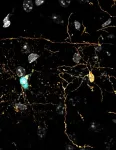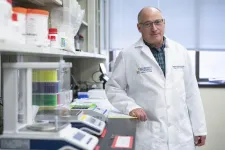(Press-News.org) For oligodendrocytes—the central nervous system cells critical for brain function—age may not bring wisdom, but it does come with the power to cling to life for much, much longer than scientists knew. That's according to a new study featured on the March 27 cover of the Journal of Neuroscience.
Mature oligodendrocytes took a shocking 45 days to die following a fatal trauma that killed younger cells within the expected 24 hours, Dartmouth researchers report. The findings suggest there's a new pathway for efforts to reverse or prevent the damage that aging and diseases such as multiple sclerosis cause to these important cells.
In the brain, oligodendrocytes wrap around the long, skinny connections between nerve cells known as axons, where they produce a lipid membrane called a myelin sheath that coats the axon. Axons transmit the electrical signals that nerve cells use to communicate; myelin sheaths—like the plastic coating on a copper wire—help these signals travel more efficiently.
Old age and neurodegenerative diseases like MS damage oligodendrocytes. When the cells die, their myelin production perishes with them, causing myelin sheaths to break down with nothing to replenish them. This can lead to the loss of motor function, feeling, and memory as neurons lose the ability to communicate.
Scientists have assumed that damaged oligodendrocytes—like all injured cells—initiate a cellular self-destruct called apoptosis in which the cells kill themselves. But Dartmouth researchers discovered that mature oligodendrocytes can experience an extended life before their death that has never been seen before. The findings pose the critical question of what in these cells changes as they mature that allows them to persist.
"We found that mature cells undertake a pathway that is still controlled, but not the classical programmed cell-death pathway," said Robert Hill, an assistant professor of biological sciences and corresponding author of the paper.
"We think this is showing us what happens in brains as we age and revealing a lot about how these cells die in older people," Hill said. "That unique mechanism is important for us to investigate further. We need to understand why these cells are following this pathway so we can potentially encourage or prevent it, depending on the disease context."
First author Timothy Chapman, who led the project as a PhD candidate in Hill's research group, said that efforts to develop treatments for preserving myelin have focused on cultivating young oligodendrocytes and protecting mature ones. But this study suggests the cells may change significantly as they age and that a one-size-fits-all treatment might not work.
"In response to the same thing, young cells go one way and old cells go another," said Chapman, who is now a postdoctoral researcher at Stanford University. "If you wanted to protect the old cells, you may have to do something completely different than if you wanted to help the young cells mature. You'll likely need a dual approach."
The paper builds on a living-tissue model the team reported in the journal Nature Neuroscience in March 2023 that allows them to initiate the death of a single oligodendrocyte to observe how the cells around it react. They reported that when an oligodendrocyte in a young brain died, the cells around it immediately replenished the lost myelin. In a brain equivalent to that of a 60-year-old, however, the surrounding cells did nothing and the myelin was lost.
"That model gets us as close as we can get to the cell-death process that happens in the brain," Hill said. "We're able to model the effects of aging really well. Our ability to select a single oligodendrocyte, watch it die, and watch it regenerate or fail to regenerate allows us to understand what drives this process at the cellular level and how it can be controlled."
For the latest study, the researchers used their model to fatally damage oligodendrocyte DNA using what amounts to a cellular death ray—a photon-based device called 2Phatal that Hill developed. They also used the standard method for removing myelin that uses the copper-based toxin cuprizone as a comparison.
As previous studies have reported, the immature cells died quickly. But the older cells lived on, which the Dartmouth team at first interpreted as a resistance to DNA damage.
The study came into focus when the researchers examined the mature cells 45 days later using a long-term, high-resolution imaging technique developed in the Hill lab. "That's when we saw that it wasn't that the cells were resistant to damage—they were experiencing this extended cell death instead," Hill said.
"No one's ever checked for cell death that long after DNA damage. It's the only example we can find in the literature where a cell experiences such a traumatic event and sticks around longer than a week," he said.
Because humans have oligodendrocytes for life, the cells are known to accumulate DNA damage and be more resilient than other cells, Chapman said. "That's why we think this effect is applicable to aging. One reason these cells may persist for such a long time is because they're used to experiencing this kind of damage naturally in aging," he said.
The study opens the first door of a vast labyrinth of more questions, Hill and Chapman say, such as whether the extended death is a good thing. It may be the equivalent of dysfunctional myelin, which is worse just sitting on an axon than if there was no myelin at all, Hill said. It isolates the cell from the surrounding tissue and essentially starves it of nutrients.
"It's almost like there is garbage sitting on the axon for 45 days. Do we want to save that garbage or speed up its removal? We didn't even know that was a question until we saw this," Hill said.
"If we understand the cell-death mechanism, maybe we can speed it up and get rid of that dysfunctional myelin," he said. "We're always trying to save the cells and save the tissue, but you have to know if they're worth saving."
###
The version of record of "Oligodendrocyte Maturation Alters the Cell Death Mechanisms That Cause Demyelination" was published March 27, 2024, in the Journal of Neuroscience. This work was supported by the National Institutes of Health (R01NS122800), the Esther A. and Joseph Klingenstein Fund, the Simons Foundation, and the Department of Biological Sciences at Dartmouth.
END
Older brain cells linger unexpectedly before their death
Dartmouth study finds cells critical for brain function survive 45 days after trauma
2024-03-28
ELSE PRESS RELEASES FROM THIS DATE:
Clear shift in arterial diseases in diabetes
2024-03-28
There has been a redistribution in the risk of arterial disease in type 1 and 2 diabetes. The risks of heart attack and stroke have decreased significantly, while complications in more peripheral vessels have increased in relative importance, according to studies at the University of Gothenburg.
It is well known that type 1 and 2 diabetes increase the risk of heart attack and stroke. Previous research has also identified the clearest cardiometabolic risk factors in this context, such as obesity, lipid disorders, and high blood pressure.
How diabetes and cardiometabolic risk factors affect blood ...
Celebrating half a century of pioneering excellence: EBMT marks its 50th anniversary
2024-03-28
Barcelona, 27 March 2024 – The EBMT proudly commemorates its 50th anniversary, marking five decades of transformative advancements in the field of hematopoietic cell transplantation (HCT) and cellular therapy. More than 5,000 healthcare professionals will gather from the 14th to the 17th of April, 2024, at the Scottish Event Campus in Glasgow for this special edition and they will immerse themselves in cutting-edge scientific content, network with their peers from across the globe, and be part of a community that is driving innovation and change.
In 1974, a small group ...
Ancient DNA reveals the appearance of a 6th century Chinese emperor
2024-03-28
What did an ancient Chinese emperor from 1,500 years ago look like? A team of researchers reconstructed the face of Chinese Emperor Wu of Northern Zhou using DNA extracted from his remains. The study, published March 28 in the journal Current Biology, suggests the emperor’s death at the age of 36 might be linked to a stroke. It also sheds light on the origin and migration patterns of a nomadic empire that once ruled parts of northeastern Asia.
Emperor Wu was a ruler of the Northern Zhou dynasty in ancient China. Under his reign from AD 560 to AD 578, Emperor Wu built a strong military and unified the northern part ...
DNA study IDs descendants of George Washington from unmarked remains, findings to aid service member IDs going back to World War II
2024-03-28
New DNA sequencing technologies have identified the historical remains of George Washington’s grandnephews, Samuel Walter Washington and George Steptoe Washington Jr., and their mother, Lucy Payne Washington, from unmarked, fragmentary bones left at the Harewood family cemetery in Charles Town, West Virginia, in the mid-1800s.
In addition to enabling the remains in question to be reunited and reburied if desired, the researchers plan to apply the validated DNA analysis techniques to their ongoing efforts to identify the remains of service members lost around the world in past conflicts going back to World War II. The findings appear March 28 in the journal iScience.
“The ...
Familial Alzheimer’s disease transferred via bone marrow transplant in mice
2024-03-28
Familial Alzheimer’s disease can be transferred via bone marrow transplant, researchers show March 28 in the journal Stem Cell Reports. When the team transplanted bone marrow stem cells from mice carrying a hereditary version of Alzheimer’s disease into normal lab mice, the recipients developed Alzheimer’s disease—and at an accelerated rate.
The study highlights the role of amyloid that originates outside of the brain in the development of Alzheimer’s disease, which changes the paradigm of Alzheimer’s from being a disease ...
Perspectives of oncologists on the ethical implications of using AI for cancer care
2024-03-28
About The Study: In this survey study of 204 oncologists, few reported that patients needed to understand artificial intelligence (AI) models, but most agreed that patients should consent to their use, and many tasked patients with choosing between physician- and AI-recommended treatment regimens. These findings suggest that the implementation of AI in oncology must include rigorous assessments of its effect on care decisions as well as decisional responsibility when problems related to AI use arise.
Authors: Gregory A. Abel, M.D., M.P.H., of the Dana-Farber Cancer Institute in Boston, is the corresponding author.
To ...
Industry payments to US physicians by specialty and product type
2024-03-28
About The Study: From 2013 to 2022, U.S. physicians received $12.1 billion from industry. More than half of physicians received at least one payment. Payments varied widely between specialties and between physicians within the same specialty. A small number of physicians received the largest amounts, often exceeding $1 million, while the median physician received much less, typically less than a hundred dollars.
Authors: Andrew J. Foy, M.D., of the Penn State Milton S. Hershey ...
Andrew E. Place, MD, PhD appointed as Dana-Farber/Boston Children’s Cancer and Blood Disorders Center Vice President, Pediatric Chief Medical Officer
2024-03-28
BOSTON -- Andrew E. Place, MD, PhD, has been named as Vice President, Pediatric Chief Medical Officer (CMO) at Dana-Farber Cancer Institute (within the Department of Pediatric Oncology) and Boston Children’s Hospital (within the Division of Hematology/Oncology) for the Dana-Farber/Boston Children’s Cancer and Blood Disorders Center.
In this role, Place will work closely with institutional and departmental leaders at Boston Children’s Hospital (BCH) and Dana-Farber to help define and implement clinical strategies and operational approaches that enhance smooth and efficient running of clinical care ...
COVID-19 antibody discovery could explain long COVID
2024-03-28
UVA Health researchers have discovered a potential explanation for some of the most perplexing mysteries of COVID-19 and long COVID. The surprising findings could lead to new treatments for the difficult acute effects of COVID-19, long COVID and possibly other viruses.
Researchers led by UVA’s Steven L. Zeichner, MD, PhD, found that COVID-19 may prompt some people’s bodies to make antibodies that act like enzymes that the body naturally uses to regulate important functions – blood pressure, for example. Related enzymes also regulate ...
Wild plants face viral surprise
2024-03-28
Just as many people battle seasonal colds and flu, native plants face their own viral threats. People have long known that plants can succumb to viruses just like humans. Now, a new study led by Michigan State University and the University of California, Riverside reveals a previously unknown threat: non-native crop viruses are infecting and jeopardizing the health of wild desert plants.
“For years, the ecological field assumed wild plants were immune to invasive viruses that damage crops,” said Carolyn ...
LAST 30 PRESS RELEASES:
Application of orthogonal CNOP-I in a convection-allowing ensemble prediction system based on CMA-MESO for improving extreme precipitation skill
Study suggests bamboo has ‘superfood’ potential
Hidden heart-care gaps among Asian American patients
Blood test predicts which patients with lung cancer will benefit from newly approved immunotherapy drug
SwRI’s Dr. Michael Davis named SPIE Fellow
Exposure to “forever chemicals” linked to higher risk of gestational diabetes, major review finds
Insilico Medicine integrates Nach01 Foundation Model with Microsoft Discovery to enable AI-native, enterprise-ready drug discovery workflows
New study reveals precursors for forecasting summer clustered extreme precipitation events in Northeast China
A bacterial toxin can counteract colorectal cancer growth
Frozen hydrogen cyanide ‘cobwebs’ offer clues to origin of life
Physics of foam strangely resembles AI training
Bis-pseudoindoxyls: a new class of single benzene-based fluorophores for bioimaging applications
Blocking a cancer-related pathway helps reduce spine deformities due to genetic disorder, finds new study
New study explores therapeutic potential of CRISPRCas3 genome-editing system
Korea University researchers revive an abandoned depression drug target using structurally novel NK1 receptor inhibitors
Jeonbuk National University researchers highlight advancements in chemical looping fluidized bed reactors
Tyrannosaurus rex grew up slowly: New study reveals the “king of dinosaurs” kept growing until age 40
Commercial water dispenser machines may contain more contamination than tap water
Death and doctors: New WSU study looks at medical student education on end-of-life care
The best hydrogen for heavy-duty transport is locally produced and green
Pregnancy-related high blood pressure varied among Asian, Pacific Islander subgroups
Measuring movement creates new way to map indoor air pollution
Europe’s crop droughts to get worse even as rain increases
New study identifies signature in blood to better predict type 2 diabetes risk
Research spotlight: developing “smart” nanoparticles to deliver targeted gene therapy in osteoarthritis
A CRISPR fingerprint of pathogenic C. auris fungi
Time warp: How marketers express time can affect what consumers buy
CBD treatment reverses key effects of fetal alcohol spectrum disorder in a mouse model
Blood sugar spikes linked to higher risk of Alzheimer's disease
Staying single for longer affects young people’s well-being
[Press-News.org] Older brain cells linger unexpectedly before their deathDartmouth study finds cells critical for brain function survive 45 days after trauma






